
- Subject:
- Anatomy/Physiology
- Life Science
- Material Type:
- Unit of Study
- Provider:
- Rice University
- Provider Set:
- OpenStax College

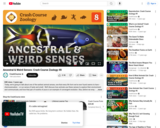
Today, we're going to talk about one of the earliest animal senses, one that every life form we've ever found seems to have -- chemosensation -- or our sense of taste and smell. We'll discuss how animals use these senses to explore their environment and communicate, and how that pair of nostrils of yours is an example of convergent evolution. Also, before we wrap up our discussion of animal senses we're going to talk about a couple so specialized that seem straight from the pages of comic books -- the ability to sense electric and magnetic fields!

This lesson will introduce camouflage and adaptations, enabling students to be able to identify the importance of animals adapting in a changing climate.

The introductory topics will cover various approaches to the study of animals and their behavior. Key concepts in studies of animal behavior, emphasizing ethology, are covered in class and in the assigned readings from Scott (2005), supplemented by selections from other books, especially from classics in the field as well as selected videos. Next, key concepts in sociobiology are covered using readings from Alcock (2001), supplemented by selections from additional books and some video presentations.
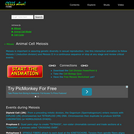
Meiosis is important in assuring genetic diversity in sexual reproduction. Use this interactive animation to follow Meiosis I (reduction division) and Meiosis II in a continuous sequence or stop at any stage and review critical events.
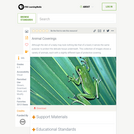
It takes a thick skin to withstand the hardships that life has to offer. This collection of images shows a variety of animals, each with a slightly different type of protective covering.
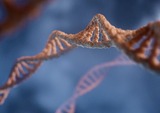
This lesson presents an overview of the role of genetics, breeding, and reproduction in animal agriculture. Learners will become familiar with fundamentals of genetics, complete a Punnett square, understand phenotypes and genotypes, identify parts of reproductive systems, and discuss breeding systems used in the animal industry. This represents a portion of the Introduction to Agriculture, Food, and Natural Resources (AFNR) series in Nebraska middle and high school agricultural education.

This resource is a video abstract of a research paper created by Research Square on behalf of its authors. It provides a synopsis that's easy to understand, and can be used to introduce the topics it covers to students, researchers, and the general public. The video's transcript is also provided in full, with a portion provided below for preview:
"“All happy families look alike; each unhappy family is unhappy in its own way” – Leo Tolstoy, Anna Karenina. According to Tolstoy, a healthy home is the result of many factors falling into harmonious order, whereas disharmony is what happens when even one of these factors is out of place. A new study confirms the same principle holds true for the communities of microbes that determine oral health. Researchers mapped microbial DNA from healthy individuals and individuals with one of three forms of gum infection: chronic periodontitis, localized aggressive periodontitis, or generalized aggressive periodontitis. While it’s known that all three forms of periodontitis are microbially derived, the microbial makeup that gives rise to each remains unclear. High-throughput whole genome sequencing revealed that, like Tolstoy's unhappy homes, no two individuals with disease were alike..."
The rest of the transcript, along with a link to the research itself, is available on the resource itself.
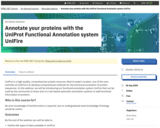
UniProt is a high quality, comprehensive protein resource. Next to expert curation, one of the core activities at UniProt is to develop computational methods for the functional annotation of protein sequences. In this webinar, we will be introducing our functional annotation system UniFire that can be used by the community to share and run rule-based automatic annotation systems to add functional information to proteins.
Who is this course for?
No prior knowledge of bioinformatics is required, but an undergraduate level knowledge of biology would be useful.
Outcomes
By the end of the webinar you will be able to:
Outline the types of data available in UniProt
Describe the automatic annotation systems used in UniProt
Describe the UniFire platform for sharing and utilising UniProt’s automatic annotation systems
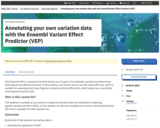
The Ensembl VEP is a powerful tool that allows you to input a list of genetic variants and determines which genes are affected and how. In this webinar, you’ll learn how to use the online VEP tool, which is suitable for analysing short lists of genetic variants, and the offline tool, which allows you to annotate whole genome variant calls.
Who is this course for?
This webinar is suitable to any clinical or research scientists who are interested in exploring genetic variants and their effect. In this webinar we will use examples from human clinical data but the VEP tool is available for other species too.
Outcomes
By the end of the webinar you will be able to:
Describe the application of VEP
Analyse short lists of genetic variants using VEP
Annotate variation data
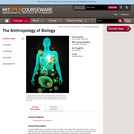
This course applies the tools of anthropology to examine biology in the age of genomics, biotechnological enterprise, biodiversity conservation, pharmaceutical bioprospecting, and synthetic biology. It examines such social concerns such as bioterrorism, genetic modification, and cloning. It offers an anthropological inquiry into how the substances and explanations of biology—ecological, organismic, cellular, molecular, genetic, informatic—are changing. It examines such artifacts as cell lines, biodiversity databases, and artificial life models, and using primary sources in biology, social studies of the life sciences, and literary and cinematic materials, and asks how we might answer Erwin Schrodinger’s 1944 question, “What Is Life?” today.

This course applies the tools of anthropology to examine biology in the age of genomics, biotechnological enterprise, biodiversity conservation, pharmaceutical bioprospecting, and synthetic biology. It examines such social concerns such as bioterrorism, genetic modification, and cloning. It offers an anthropological inquiry into how the substances and explanations of biology — ecological, organismic, cellular, molecular, genetic, informatic — are changing. The course also examines such artifacts as cell lines, biodiversity databases, and artificial life models, and using primary sources in biology, social studies of the life sciences, and literary and cinematic materials, asks how we might answer Erwin Schrödinger’s 1944 question, “What Is Life?”, today.

This course applies the tools of anthropology to examine biology in the age of genomics, biotechnological enterprise, biodiversity conservation, pharmaceutical bioprospecting, and synthetic biology. It examines such social concerns such as bioterrorism, genetic modification, and cloning. It offers an anthropological inquiry into how the substances and explanations of biology—ecological, organismic, cellular, molecular, genetic, informatic—are changing. It examines such artifacts as cell lines, biodiversity databases, and artificial life models, and using primary sources in biology, social studies of the life sciences, and literary and cinematic materials, and asks how we might answer Erwin Schrodinger’s 1944 question, “What Is Life?” today.

This course explores a range of contemporary scholarship oriented to the study of ‘cybercultures,’ with a focus on research inspired by ethnographic and more broadly anthropological perspectives. Taking anthropology as a resource for cultural critique, the course will be organized through a set of readings chosen to illustrate central topics concerning the cultural and material practices that comprise digital technologies. We’ll examine social histories of automata and automation; the trope of the ‘cyber’ and its origins in the emergence of cybernetics during the last century; cybergeographies and politics; robots, agents and humanlike machines; bioinformatics and artificial life; online sociality and the cyborg imaginary; ubiquitous and mobile computing; ethnographies of research and development; and geeks, gamers and hacktivists. We’ll close by considering the implications for all of these topics of emerging reconceptualizations of sociomaterial relations, informed by feminist science and technology studies.

This class has been reorganized to focus primarily on the War in Iraq. As in previous years, the class still examines war in cross-cultural perspective, asking whether war is intrinsic to human nature, what causes war, how particular cultural experiences of war differ, and how war has affected American culture.
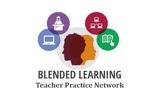
Antibiotics save people’s lives...and make bacteria stronger and more likely to kill us. What is the best practice to balance these conflicting issues? In this problem-based learning module, the students will be evaluating real-life medical situations in conjunction with actual staff at those institutions and offering action plans to be ‘implemented’ there. In order to accomplish this, the science unit will be interlocking with social studies and a language arts unit that will have them identifying target audiences and sculpting a way to present their findings. This unit has the potential to be a full problem-based unit as well as highly interdisciplinary--it’s connected to full units in social studies and language arts which stand alone but can be fully integrated if desired.
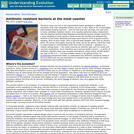
The pork chops you buy in the supermarket neatly packaged in plastic and styrofoam may look completely sterile, but are, in fact, likely to be contaminated with disease-causing bacteria - and not with just any old bugs, but with hard-to-treat, antibiotic resistant strains. In a recently published study, researchers with the National Antimicrobial Resistance Monitoring System bought meat from a wide sampling of chain grocery stores across the country and analyzed the bacteria on the meat. Resistant microbes were found in 81% of ground turkey samples, 69% of pork chops, 55% of ground beef samples, and 39% of chicken parts.

This resource is a video abstract of a research paper created by Research Square on behalf of its authors. It provides a synopsis that's easy to understand, and can be used to introduce the topics it covers to students, researchers, and the general public. The video's transcript is also provided in full, with a portion provided below for preview:
"Antibiotics are critical treatments for bacterial infections, but antibiotic resistance is a growing problem. Wastewater treatment plants may foster resistance development, since sewage contains both human pathogens and antibiotics or their metabolite. The activated sludge (AS) stage commonly used to treat sewage at these plants is especially microbe-rich and may encourage transfer of antibiotic resistance genes (ARGs) through reproduction (vertical transfer) or movement of mobile genetic elements (horizontal transfer). To learn more, a recent study profiled ARGs and their neighboring genes at five wastewater treatment plants on three continents. Overall, ARG abundance was lower in AS than in incoming sewage (IN). In addition, ARGs tended to colocalize with plasmids and other mobile genetic elements to a greater extent in IN than AS, indicating decreased horizontal transfer potential..."
The rest of the transcript, along with a link to the research itself, is available on the resource itself.

This resource is a video abstract of a research paper created by Research Square on behalf of its authors. It provides a synopsis that's easy to understand, and can be used to introduce the topics it covers to students, researchers, and the general public. The video's transcript is also provided in full, with a portion provided below for preview:
"Antibiotic resistance is a growing problem worldwide—and in outer space. Spaceflight can promote biofilm formation and antimicrobial resistance development, and astronauts are especially vulnerable to infection due to the unique demands of spaceflight. To support future space travel, it is critical to understand exactly how spaceflight affects microbial diversity and virulence. To learn more, researchers recently used a machine learning algorithm to analyze sequencing data from the Microbial Tracking (MT)-1 mission, which sampled microbes at eight locations on the International Space Station during three flights. The model predicted the presence of hundreds of antibiotic resistance genes (ARGs) in the 226 bacterial strains isolated from the flights, including strains of the potentially very pathogenic bacterium Enterobacter bugandensis and the food poisoning-related bacterium Bacillus cereus..."
The rest of the transcript, along with a link to the research itself, is available on the resource itself.